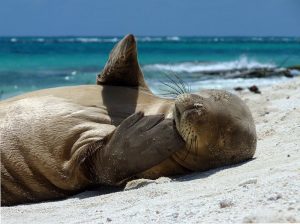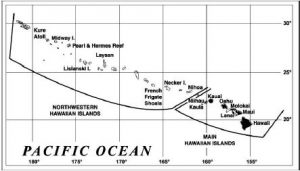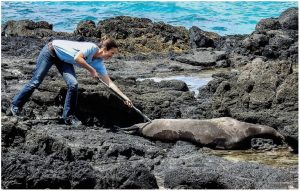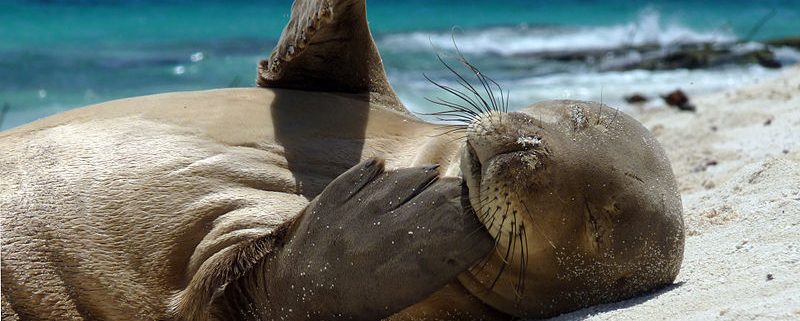Hawaiian Monk Seal Conservation
By Abby Tinari, SRC intern
Monk seals are warm water species historically residing in the Caribbean, Mediterranean and Hawaii. Now only Mediterranean and Hawaiian populations remain, both of which are critically endangered according to the International Union of Conservation of Nature (ICUN). Hawaiian monk seals have an estimated 1300 wild individuals living around the Hawaiian archipelago.

Figure 1: A juvenile Hawaiian monk seal at French Frigate Shoals. (MarkSullivan, Wikimedia)
In the early 1800s thousands of these seals were hunted for their meat, skin and oil. At the end of the 19th century and early into the 20th, the species was thought to be close to extinction. In 1958, the first beach count of the species was conducted, and surveyors concluded that the Hawaiian monk seal had made a partial recovery (Schultz, Baker et al. 2011). This was short lived. The population has since declined and is declining 4% per year on some Hawaiian Islands. These declines are due to a low juvenile survival rate because of starvation, shark predation, marine debris entanglement, by catch, sea-level rise and intra-specific male seal aggression (Schultz, Baker et al. (2011) & Norris, Littnan et al. (2017)). These seals have been consistently monitored since the 1980s when they were placed on the endangered species list. Scientists started going to pupping grounds to tag, sample and identify individuals (Baker and Thompson 2007). The Baker and Thompson (2007) study observed that the Hawaiian monk seal population is senescing, or growing older and less reproductive. Females give birth to a single pup after a 10-11 month gestation period. She then nurses the pup for 5-6 weeks. So, reproduction rates are relatively low to begin with, plus a low survival rate in the first 2 years of life is hurting the populations long term growth rate (Baker and Thompson 2007). Norris, Littnan et al. (2017) indicated that one of the main threats to young seals, less than 2 years old, is the lack of available prey.

Figure 2: The Hawaiian Archipelago, with demarcations showing the extent of the Northwestern and main Hawaiian Islands. Place names of most islands and atolls where Hawaiian monk seals (Neomonachus schauinslandi) occur are noted. (Baker, Harting et al. 2017)
With now almost 40 years on the ICUN’s endangered and critically endangered list there have been attempts at conservation. Two of these methods include translocation and vaccination. Translocation was used in the past with mixed results, some seals survived while others unfortunately did not. Schultz, Baker et al 2011 write about using genetics among other factors to see if a population is more likely to have long term success with translocation. If subpopulations have a wide genetic diversity and many genetic differences between them, then translocation may not be the best solution and could potentially produce unfit individuals. On the other hand, less genetically diverse subpopulations would have a higher success rate with fit individuals through translocation. Hawaiian monk seals were thought to have had separate subpopulations throughout the archipelago, due to the spatial distance between the islands. After genetic analysis of over 1800 individuals over 13 years Schultz, Baker et al 2011 found that the subpopulations are genetically not statistically different, they in fact, comprise of a single population. This is good news for translocation, it could be an effective means of conservation if the new location is suitable. Norris, Littnan et al. (2017) supports Schultz’s findings. Weanling seals just learning how to hunt on their own were translocated to a new island that had an abundant amount of food and few seals. The habitat was also ideal, providing adequate depth, and bottom type for both young and adult seals to hunt successfully. There was a small difference between the resident and translocated seal survival into adulthood. This survival rate is an essential marker for a translocation program. Translocation is a great way to increase numbers and repopulate suitable locations, but other conservation methods may be equally, if not more, important to a population’s survival.

Figure 3: Stacie Robinson, a biologist with the National Oceanic and Atmospheric Administration in Honolulu, vaccinates a Hawaiian monk seal basking on the island of Oahu. (Malakoff 2016)
For the first time ever, a wild population of marine mammals is receiving a vaccine to prevent disease (Malakoff 2016). This has previously occurred in the terrestrial environment mainly to prevent the spreading of rabies in racoons and fox, but never in free-living marine mammals. The lack of genetic diversity, low population, and isolation the Hawaiian monk seal experiences makes it extremely susceptible to infection. But, these factors also make the seals a prime candidate for this vaccine. Scientists are wary of the spread of viruses in the Morbillivirus family. This genus of viruses has killed tens of thousands of seals and porpoises in the Atlantic Ocean. These viruses are easily spread and are possibly carried to the Hawaiian Islands by whales, stray seals and dogs. An outbreak among the monk seals could prove deadly and cause devastating decreases in an already struggling population. The vaccine is targeting the phocine distemper virus (PDV), which needs two shots, a first dose and then a booster 4-6 weeks later. The seals habits of “hauling out”, lying on the beach and rocks, their numbered tags, small population size and unique markings help with the recapture needed to complete the vaccine. Before the vaccines were implemented, model simulations of different scenarios were run to see if preventative vaccination would be worthwhile. Baker, Harting et al. (2017) along with Malakoff (2016) determined that preventative vaccination is the most effective way of protecting these seals from an Morbillivirus outbreak. In 2016, scientists started to vaccinate individuals at the Oahu “haul out”, as this is a midpoint between the subpopulations. 60% of the overall population would need to be vaccinated in order to prevent a local outbreak of PDV. Malakoff (2016) and Baker, Harting et al. (2017) provide some limitations to the vaccines. For future seals to be immune the vaccine will need to be continued and new pups will need to be vaccinated. These vaccines are not always available and are limited in quantity. To get to the seals, scientists must walk through tide pools and over lava rock which can be dangerous especially when dealing with wild animals. The vaccine takes over a month to provide protection which leaves the seals vulnerable. Also, the vaccines currently being used are for a different strain of PDV so this effort could be futile. Either way, this is a milestone for conservation and could be the protection the Hawaiian monk seals need to build a successful future.
Works Cited
Baker, J. D., A. L. Harting, M. M. Barbieri, S. J. Robinson, F. M. D. Gulland and C. L. Littnan (2017). “Modeling a Morbillivirus Outbreak in Hawaiian Monk Seals (Neomonachus Schauinslandi) to Aid in the Design of Mitigation Programs.” J Wildl Dis 53(4): 736-748.
Baker, J. D. and P. M. Thompson (2007). “Temporal and spatial variation in age-specific survival rates of a long-lived mammal, the Hawaiian monk seal.” Proc Biol Sci 274(1608): 407-415.
Malakoff, D. (2016). “CONSERVATION BIOLOGY. A race to vaccinate rare seals.” Science 352(6291): 1265.
Norris, T. A., C. L. Littnan, F. M. D. Gulland, J. D. Baker and J. T. Harvey (2017). “An integrated approach for assessing translocation as an effective conservation tool for Hawaiian monk seals.” Endangered Species Research 32: 103-115.
Schultz, J. K., J. D. Baker, R. J. Toonen, A. L. Harting and B. W. Bowen (2011). “Range-wide genetic connectivity of the Hawaiian monk seal and implications for translocation.” Conserv Biol 25(1): 124-132.




Leave a Reply
Want to join the discussion?Feel free to contribute!